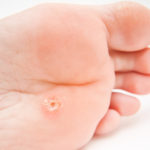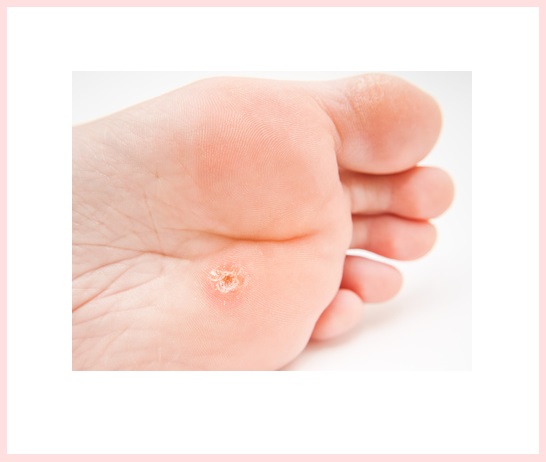What is a wart
Warts (verruca), otherwise knows as planter (foot) warts are very common. Most people will experience having a wart at some point in their life. Warts (verruca) are caused by the human papilloma virus and they make rough, small growths or lumps appear on your skin. You can get warts (verruca) anywhere but they most often pop up on your knees, hands, and feet. A wart that appears on the sole of your foot is known as a verruca.
Who gets warts (other than witches in fairytales!)
Warts (verruca) are most commonly seen in adolescents and school aged children. Warts (verruca) in many cases will disappear instantaneously, but this process can possibly take a long time, up to ten years even! If you are unlucky one can multiply into many. The worst case of foot warts that I have ever seen in my Podiatry career has stayed clearly in my mind for 35 year. A healthy 26 year male. First wart appeared under the right big toe when he was 16 years old. By the time I saw him, 8 years later the warts covered the soles of both feet, up the back of the right heel and in between the toes on both feet.
Should you treat warts or let them self-resolve
I have seen many Warts (verruca). Some disappear, some don’t. How do you know which warts will and which warts get out of control? Having seen the worst case scenario, I would never leave a wart unattended. However medical attention is not always required. There are many over the counter treatments you can purchase in order to take care of your wart problem. The older you are the longer it generally takes for your warts to go away and for this reason many people turn to quicker methods of wart removal.
What does a wart look or feel like
Warts (verruca) are usually characterized by small black dots in the middle on the warts, and they are often times painful and sensitive to touch when put under weight or pressure. As they are usually under the foot they tend to appear flat due to the pressure that is put on them all day when you walk around. Warts (verruca) are extremely contagious and are spread very easily by directly contacting the skin of another infected person. You can also catch warts (verruca) by coming in direct contact with any floors or surfaces that may contaminated by the virus. Infection most often occurs in public swimming pools and showers, or places where your skin is likely to be damaged and wet while you are there. If you scratch a wart, it may release particles that can spread to other areas of your body and cause warts (verruca) there as well. People who work in abattoirs and people who handle meat like butchers are extremely prone to catching warts (verruca). There are other things that feel or look similar to warts. Be careful that you have identified correctly.
Does your immunity affect warts
If your immune system is weakened, you are at a heightened risk for contracting warts (verruca) as well.
Similarly, if you get a wart, stimulating your immune system may actually accelerate the resolution Having seen treatments work on one person, but not another I firmly believe there is an X Factor involved in getting rid of a wart.
Stop the Spread
If you want to prevent yourself from catching warts (verruca), there are a few ways you can do this. Do not come into direct contact with other people’s warts or any surfaces that may contain the warts (verruca) virus. Also do not share articles of clothing like towels, socks or shoes with other people. Always wear flip flops when walking around in locker-rooms or public showers.
If you or a family member has a wart, make sure you cover it with a plastic covering before you go swimming in a public pool as well. You should be using your own bathmat too. If you want to file your wart down a little bit so it isn’t so rough, make sure you do not use the same file on other areas of your body, as particles from the wart can spread there and give you more warts.
DON’T PICK AT YOUR WART with your FINGERNAILS.
I know it is tempting. Just DON’T
Common treatments
For getting rid of warts (verruca) completely, there are many methods.
Over-the-counter and use-at-home remedies
Please be careful and sensible. Read the instructions carefully and seek professional help if pain, redness, swelling or uncertainty occurs
Cryotherapy
One of these is called cryotherapy. This essentially involves freezing the wart right off of your skin, with liquid nitrogen. Your doctor will put the liquid nitrogen on your wart with a spray or a ball of cotton for anywhere from five and thirty seconds. You may need to continue using cryotherapy up to six times for it to completely remove your wart. Cryotherapy is not often recommended for children because it is painful and in some cases can lead to scarring or blistering of the skin. Also if you have poor circulation or reduced sensation Cryotherapy is not recommended
Salicylic Acid
Salicylic acid is another popular method for treating your warts (verruca). It is used to soften the hard outer layer of the wart. Keeping the area constantly covered and dry can be a nuisance. Careful masking of the surrounding skin is also important to reduce enlarging the area of acid contact / action.
Surgical intervention
If none of those methods work for removing your warts (verruca), you may need to undergo surgery. Your warts can sometimes be scraped off with something knows as a curette, or Laser can be used. Both of these methods may leave scars, but are done with anaesthesia so you won’t feel pain during them. Leaving scars on the plantar surface (bottom) of the foot sometimes results in a lifelong callus or corn. This is not a desirable outcome. Who you choose for surgical intervention will take a bit of research. I have spoken to many Podiatrists who report excellent results with no scarring. I have not used these methods.



